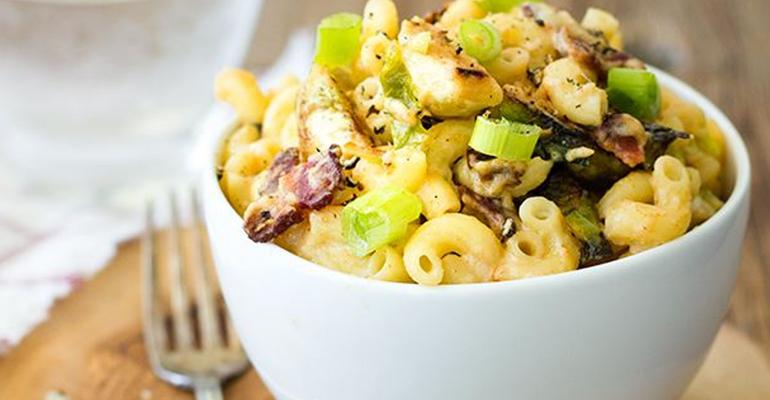Sponsored by Arla USA Foodservice
Cheese is a seemingly simple way to elevate just about any menu item, adding flavor, texture and, sometimes, that elusive “wow” factor. But slicing, shredding or sprinkling lackluster varieties of cheese on entrées or appetizers rarely wins over hard-to-please customers. To increase the likelihood of success of comfort food favorites such as burgers and brisket sandwiches, and limited-time offers like specialty salads and bowls, operators need to choose just the right cheese.
There’s a world of premium, standout cheese out there ripe for the menuing. Below we share insights on the cheese varieties growing on menus from Chicago-based foodservice market research firm Datassential MenuTrends. Also included are suggestions on how to serve them for maximum appeal.
SMOKED GOUDA. Trend watchers predict that as consumers become less concerned about full-fat foods and more interested in those with full flavor, an increasing number of operators will choose to menu cheeses such as Smoked Gouda, a creamy, melty variety that is optimal for indulgence. Smoked cheese of several varieties appears on 10% of menus, up 13% in the last four years, says Datassential.
How to menu Smoked Gouda: The smoky, meltiness of Gouda makes it ideal for such indulgent classics as a crunchy-on-the-outside, gooey-on-the-inside grilled cheese sandwich. It is also ideal in creamy, cheesy dips to accompany everything from pigs in a blanket to french fries, or for punching up pot stickers or pizzas. Of course, Smoked Gouda is good on its own served, for example, with a side of sliced Honeycrisp apples.
BLUE CHEESE. In the last few years there has been an uptick in all manner of bold-flavored cheeses on the market. Among them, blue cheese, a class of cheeses known for having distinct blue-grey spots or veins and an assertive flavor. Long a top-menued cheese, blue is surpassed only by Parmesan, cheddar and mozzarella. Appearing on 4% more menus than they did four years ago, versatile blues are expected to continue to grow in popularity.
How to menu Blue Cheeses: From Danish Blue to Roquefort to everything in between, blue cheeses are tops for many menu applications. A hunk of blue adds color, texture and boldness to cheese boards. Crumbled in meatballs it yields an appetizer with a bite. Blue melts perfectly atop a burger or other meaty sandwiches. And, of course, a good blue makes the perfect dressing for classic dishes, such as Buffalo wings or a wedge salad.
HAVARTI. A perennial favorite, this semi-soft, tangy Danish cow’s milk cheese with tiny holes is on the order of a Swiss cheese. Sometimes used in place of stronger cheeses such as Gouda or Emmenthaler, havarti provides a similar flavor and texture with a slightly subtler touch, making it appealing to young palates and mature cheese lovers alike.
How to menu havarti: Havarti is a get-along kind of cheese, complementing a wide variety of foods. Try using it on sandwiches — melted or not — such as country ham, herb roasted turkey and hot roast beef. Shred it on top of pizza by itself or in combination with mozzarella or Parmesan. Use it in a classic casserole or favorite gratin, or try it melted with ham and orange marmalade in a waffle sandwich for a savory-meets-sweet morning menu item.
HALLOUMI. This grilling cheese is a semi-hard, unripened, brined cheese made from goat's milk. Long a staple of Mediterranean and Middle Eastern cuisines, halloumi has gained serious popularity in the U.S. as of late. In the last four years alone, halloumi has grown by 85% on menus, making it one of the fastest-growing cheese varieties out there. Part of the cheese’s popularity is likely due to its ethnic origins, as more consumers are showing interest in global ingredients and cuisines.
How to menu halloumi: Designed not to melt, halloumi is ideal for pan grilling with olive oil, and then serving atop salads or grain bowls for added flavor, texture and protein. Or just grill and serve halloumi by itself as a flavorful appetizer.
Additionally, halloumi and other cheeses can play an important role in menu development as more consumers seek out plant-forward menu selections. Fifty-four percent of consumers would like to eat more plant-based foods and beverages, according to The Hartman Group. However, that does not mean they want to eliminate cheese; in fact, it presents an opportunity for operators to include premium cheese in plant-based menu items as a means to add flavor, functionality and nutrition.
Whether devising comfort food favorites or newer plant-based items, the question when considering ways to elevate menu items isn’t whether or not to add cheese, but rather which one to add. Operators who truly want to step up their menu will want to choose standout premium cheeses.




